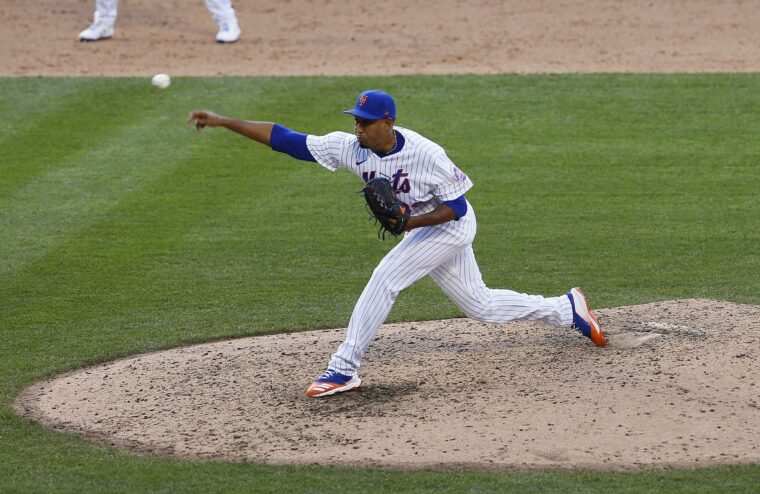
The start of Edwin Diaz‘s second year with the New York Mets likely isn’t going exactly how he planned. It’s a helluva lot better so far than his first campaign in Queens, though.
Everything went according to plan for the Mets on Opening Day — Jacob deGrom dominated, Yoenis Cespedes hit a go-ahead homer, and Diaz looked great in an uneventful ninth inning for his first save of the year. But then the right-hander tried closing out another game against the Atlanta Braves the following day and ended up blowing the save opportunity.
Since then, Diaz has received just one more shot to record a save for New York, and he wasn’t able to convert. Even with limited chances to be the team’s closer — which is what he was originally acquired for — the 26-year-old has flashed a version of the pitcher the Mets were hoping to get in the first place.
It can be tough looking at relief pitcher statistics because of the sample size, especially at the start of a year. Diaz has only thrown 10.2 innings, but it’s clear he’s turned things around after a rough start.
While his month of July consisted of just 2.1 frames, it yielded a 7.71 ERA, a 38.5% strikeout rate, and an eye-opening (in the worst way possible) 23.1% walk rate. August has been a completely different story in a larger sample size (8.1 innings): a sparkling 1.08 ERA with a 55.9% strikeout rate and 5.9% walk rate.
In fact, Diaz’s season-long strikeout rate is currently sitting at 51.1%, which is baseball’s second-highest rate heading into Monday’s action. The biggest turnaround for the former Seattle Mariner is the execution of his pitches. Diaz’s fastball gets a lot of attention because he can throw it so hard — his 97.8 mph average velocity is among the highest in baseball for qualified relievers.
As attractive as that pitch may look, it’s never been his go-to offering to get an out. Those duties have belonged to his slider. The 2019 season has been the only time Diaz’s fastball produced a higher strikeout rate and lower wRC+ allowed than his slider.

So far in 2020, though, the tide has turned in these particular departments. His four-seamer has produced a 37.5% strikeout rate with a 185 wRC+ allowed, while his slider has racked up an insane 65.2% strikeout rate with just a 1 wRC+ allowed.
If we use FanGraphs’ pitch value on a per-1oo-pitch basis to gauge the effectiveness of Diaz’s slider, it checks out here, too. That number is currently sitting at 3.04. That’s not only one of the better marks for relievers this year, but it also is head-and-shoulders above last year’s number (-0.78) and is on track to be the second-best mark of his career (3.76 as a rookie).
One of the most glaring aspects of Diaz’s underperformance in 2019 was the number of home runs he surrendered, as his home runs allowed per nine innings rate finished at a ghastly 2.33. That number is all the way down to a more palatable 0.84 because he’s only allowed one tater up to this point, and it came on what appeared to be at least a reasonably well-placed four-seamer.
Keeping this that way will be a huge key for Diaz moving forward. Between 2016 and 2018, he had allowed just five total homers off his slider, but he allowed six off that pitch just last year. What’s really eye-opening about this particular offering is how much the plate-discipline numbers have shifted in a positive direction when compared to 2019.

Yes, yes, it’s only been 10-plus innings we’re drawing comparisons from, but this is encouraging — most notably what’s going on within the strike zone. While Diaz’s slider is drawing more swings in the zone, the contact rate is down a whopping 30 percentage points. That’ll definitely play.
This year was already going to be a defining one for Diaz because of how badly he performed during his first tour with the Mets. As things have evolved here during the first few weeks of the season, this solid start (2.53 ERA, 0.5 fWAR) is even more important because of the current situation. A lack of starting rotation depth has already pulled Robert Gsellman from the bullpen and will do the same to Seth Lugo once New York starts playing again.
Lugo turning back into a starter is a huge loss for the backend of the bullpen, especially since positive results haven’t exactly happened yet for Jeurys Familia or Dellin Betances in the early going. The Mets will need Diaz to be at the top of his game more often than not whenever he’s brought in with games on the line.
If there’s one thing we can be sure of, it’s that he’ll enter these contests with a little more confidence because his slider is back to being among the best in baseball and his most effective pitch, which will dictate his ultimate fate on the mound. There was no magic in that pitch last year, and it showed. It looks like the magic has returned, and the results are confirming such a notion.
Now we just need to the magic to stick around for an extended period of time so he can continue erasing last year’s poor performance from everyone’s memory.
















